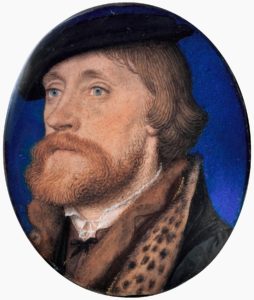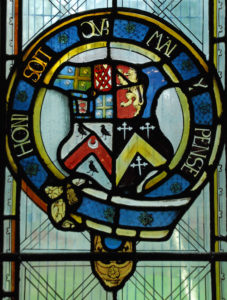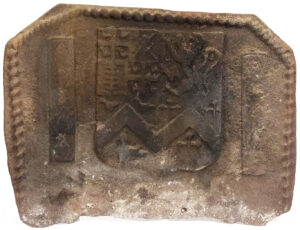
I first came across what I thought was this fireback in a scrapbook compiled by John Starkie Gardner, an early and well-informed writer on firebacks, who had been Keeper of Metalwork at what was then the South Kensington Museum but is now the Victoria and Albert Museum – the V&A. He had assembled hundreds of photographs, sketches and cuttings from publications and pasted them into several of these scrapbooks which were then at the Beecroft Gallery in Westcliff-on-Sea in Essex. They are now in the V&A Archive of Art and Design. The cutting gave no clue as to where it had been taken from. I saw the actual fireback when I visited a lovely house in Huddington, Worcestershire, to record an interesting collection there. I had no idea at the time whose elaborate arms were displayed on its surface and I feared it would be a difficult task trying to identify them given the indistinct detail on the casting. Its irregular shape also suggested it might have once been a larger fireback cut down, perhaps to fit in a smaller hearth.


As is so often the case when I have tried to identify arms on firebacks, luck played its part and I spotted the shield on a 17th century map of Hampshire. They were the arms of the Earls of Southampton, whose most distinguished member, and likely subject of the fireback, was Thomas Wriothesley, Lord Chancellor at the end of Henry VIII’s reign. In Hilary Mantel’s best-selling novels on the life of Thomas Cromwell, Bring up the Bodies and The Mirror and the Light, she has him announcing himself with “Call me Risley” to explain the pronunciation of his name. He was drawn and painted by Holbein, and his arms are displayed on his 1545 Garter stall plate in St George’s Chapel, Windsor, and on a window in the parish church at South Warnborough, Hampshire.

As to the source of the fireback it was not until I had made the acquaintance of a collector at Wigmore in Herefordshire, who sent me photographs of the backs in his possession, that I was able to associate the Huddington fireback with a known series. As well as Wriothesley’s arms, on the Wigmore fireback are 13 little figures that are stamps frequently seen on what I have termed the ‘Royal’ series of firebacks. Some writers have described them as ‘mummers’ or ‘imps’, their postures suggesting mischief-making, and they can be seen in three forms on different backs in the series.
I subsequently discovered where Starkie Gardner had found the clipping that had alerted me to this fireback. It was in an article he had written on ‘Old Wealden Ironwork at Warnham Court’ in Country Life in 1907. Warnham Court in Sussex, then the property of Mr C. J. Lucas, had a collection of firebacks that appeared as illustrations in several of Starkie Gardner’s published works. But the fireback at Warnham was not the same one as I had seen at Huddington, for the twisted rope edging was different and the rope crosses below the shield, presumably apotropaic, or intended to avert evil, were a different shape too, although the overall shape of the back was very similar and presumably not trimmed, as I had previously thought. So there had been at least two similar castings with Wriothesley’s shield in addition to the Wigmore one.


POST SCRIPT:
Since writing the above another Wriothesley fireback appeared on an American auction website. It appears to be identical to the Warnham Court casting, and it has the vestige of a cross at the bottom left. Is it one and the same? There is no record of what happened to the firebacks there; the Lucas family still live in Warnham Park and I have asked them.